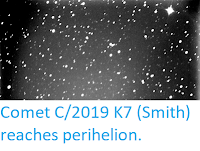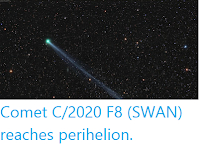The June Bootid Meteor Shower is visible each year between 26 June and 2 July, typically peaking on 27 June. This meteor shower if highly unpredictable in nature, with most years producing very few meteors, but the shower occasionally having peak years, in which hundreds of meteors are visible each hour; the most recent of such peak years happened in 1998, with the three peaks prior to that happening in 1927, 1921, and 1916. The shower has a radiant point (point from which the meteors appear to radiate) in the constellation of Boötes, close to the North Pole, making the shower possible to spot from anywhere in the Northern Hemisphere, but hard to see in the Southern Hemisphere. As the Moon will be in its First Quarter and in the constellation of Leo this year, it will present little problem to the viewing of the June Bootids.
The radiant point of the June Bootid Meteor Shower. Space Weather.
Meteor showers are thought to be largely composed of material from the
tails of comets. Comets are composed largely of ice (mostly water and
carbon
dioxide), and when they fall into the inner Solar System the outer
layers of this boil away, forming a visible tail (which always points
away from the Sun, not in the direction the comet is coming from, as our
Earth-bound experience would lead us to expect). Particles of rock and
dust from within the comet are freed by this melting (strictly
sublimation, transforming directly from a solid to a gas due to the low pressure on it's surface) of the comet into the tail and continue to orbit in the
same path as the comet, falling behind over time.
The Earth passing through a stream of comet dust, resulting in a meteor shower. Not to scale. Astro Bob.
The June Bootids Meteor Shower is caused by the Earth passing through the trail of
comet 7P/Pons-Winnecke, where it encounters thousands of tiny dust particles
shed from the comet as its icy surface is melted (strictly sublimated)
by the heat of the Sun. 7P/Pons-Winnecke visits the Inner Solar System every 6.37 years, most recently in 2015, and last came close to the Earth on 1927.
How the passage of the Earth through a meteor shower creates a radiant point from which they can be observed. In The Sky.
7P/Pons-Winnecke was discovered on 12 June 1819 by French astronomer Jean-Louis Pons, then based at Marseilles Observatory, and rediscovered by Friedrich August Theodor Winnecke at Pulkovo Observatory near Saint Petersburg. The designation 7P/Pons-Winnecke implies that it was the seventh comet discovered (7/ - strictly speaking people had been observing comets for thousands of years, but it was not until the mid-eighteenth century that it was realised that they were predictable objects that returned cyclically), that it is a periodic comet (P - again, most comets are periodic, but the term 'periodic comet' is reserved for those with periods of less than 200 years, since these can be reliably predicted), and that it was discovered by Pons and Winnecke.
7P/Pons-Winnecke
immaged on 23 September 2015 from Kiev, Ukraine. The image is a single
300 second exposure, with the slightly elongate objects being stars that
have moved over the course of the exposure. Alexander Baransky/Kiev Comet Station/Fachgruppe Kometen.
Comet 7P/Pons-Winnecke currently completes one orbit every 2326 days (6.37 years) on
an eccentric orbit tilted at 22.3° to the plane of the Solar System,
that takes it from 1.26 AU from the Sun (126% of the
average distance at which the Earth orbits the Sun) to 5.61 AU from the
Sun
(5.61 times as far from the Sun as the Earth, and slightly outside the orbit of Jupiter). As a
comet with a period of less
than 20 years with an orbit angled at less than 30° to the plane of the
Solar System, 7P/Pons-Winnecke is considered to be a Jupiter Family Comet.
The orbit and current position of 7P/Pons-Winnecke. The Sky Live 3D Solar System Simulator.
This orbit means that 7P/Pons-Winnecke occasionally comes close to the Earth, with the last close approach having happened in July 1945, and the next predicted for June 2021, when it will reach a distance of 0.44 AU from the Earth (44% of the distance between the Earth and the Sun, or 66 107 000 km).
See also...
Follow Sciency Thoughts on Facebook.











